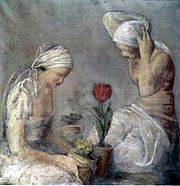
Leopold Gottlieb
Encyclopedia

Poland
Poland , officially the Republic of Poland , is a country in Central Europe bordered by Germany to the west; the Czech Republic and Slovakia to the south; Ukraine, Belarus and Lithuania to the east; and the Baltic Sea and Kaliningrad Oblast, a Russian exclave, to the north...
painter
Painting
Painting is the practice of applying paint, pigment, color or other medium to a surface . The application of the medium is commonly applied to the base with a brush but other objects can be used. In art, the term painting describes both the act and the result of the action. However, painting is...
. His brother, painter Maurycy Gottlieb
Maurycy Gottlieb
Maurycy Gottlieb was a Jewish painter, of Polish-speaking Galician Jews from the western part of Ukraine. He was born in Drohobych , Galicia, modern Lviv region, western Ukraine....
, died before Leopold was born.
Early Life & Education
Leopold Gottlieb began his formal art education at the Academy of Fine Arts in Krakow under the direction of Jacek MalczewskiJacek Malczewski
Jacek Malczewski was one of the most famous painters of Polish Symbolism. In his creativity he successfully joins the predominant style of his times with motifs of Polish martyrdom.-See also:...
. After graduating the academy, he moved to Munich to continue his studies in the studio of Anton Azbego.
Early Career in Paris
In 1904, at the age of 21 he settled in Paris and became a member of the Circle of Montparnasse artists. During the years 1904-1907, he exhibited his works in group exhibitions with four other fellow artists in KrakowKraków
Kraków also Krakow, or Cracow , is the second largest and one of the oldest cities in Poland. Situated on the Vistula River in the Lesser Poland region, the city dates back to the 7th century. Kraków has traditionally been one of the leading centres of Polish academic, cultural, and artistic life...
, Lvov, Vienna
Vienna
Vienna is the capital and largest city of the Republic of Austria and one of the nine states of Austria. Vienna is Austria's primary city, with a population of about 1.723 million , and is by far the largest city in Austria, as well as its cultural, economic, and political centre...
, Berlin
Berlin
Berlin is the capital city of Germany and is one of the 16 states of Germany. With a population of 3.45 million people, Berlin is Germany's largest city. It is the second most populous city proper and the seventh most populous urban area in the European Union...
, and Warszawa
Warsaw
Warsaw is the capital and largest city of Poland. It is located on the Vistula River, roughly from the Baltic Sea and from the Carpathian Mountains. Its population in 2010 was estimated at 1,716,855 residents with a greater metropolitan area of 2,631,902 residents, making Warsaw the 10th most...
. In 1910, he moved to Jerusalem to teach in the Bezalel School of Art. Following his return to Paris In the years 1917-1919, he took part in exhibition of Polish Expressionists (Formists) and became friends with another Polish artist, Moses Kisling, Eugene Zak and Mela Muter. His artistic talent was acknowledged by the esteemed critics of that time, André Salmon and Adolf Basler, and his works were displayed in the Salon of Autumn, Independents, Société Nationale des Beaux Artes, and the Tuileries. He participated in exhibitions in the Vienna Secession
Vienna Secession
The Vienna Secession was formed in 1897 by a group of Austrian artists who had resigned from the Association of Austrian Artists, housed in the Vienna Künstlerhaus. This movement included painters, sculptors, and architects...
. He also participated in the exhibition of Polish art, organized in 1912, Jose Galeries Dalmau in Barcelona.
First World War
During the First World War he joined the Polish Legions. During his service in the Legions, he used to draw and document scenes depicting everyday life in the camp and the life of his fellow soldier commanders. His drawings and lithographs were presented in the "Exhibition of Polish Legions," which took place in Lublin in 1917. After the war, he settled in Poland, in Vienna, and then in Germany.In 1926, he returned to Paris where he exhibited at the Galerie aux Quatre Chemins (1927), d'Art de Montparnasse (1928), Bonaparte (1930), and Zak (1934). In 1929 and 1930, he joined the exhibition of the Association of Polish Artists.
Artistic Style
Gottlieb's paintings often depict biblical themes with range of brown, green, and pink pearl tones that intensify with linear rhythm. This rhythm makes the images gain characteristics of ritual ceremony or music. The content of his painting display a rich language of icons and symbols which are drawn from Christian iconography. Gottlieb also painted many portraitPortrait
thumb|250px|right|Portrait of [[Thomas Jefferson]] by [[Rembrandt Peale]], 1805. [[New-York Historical Society]].A portrait is a painting, photograph, sculpture, or other artistic representation of a person, in which the face and its expression is predominant. The intent is to display the likeness,...
s of famous people, including Diego Rivera
Diego Rivera
Diego María de la Concepción Juan Nepomuceno Estanislao de la Rivera y Barrientos Acosta y Rodríguez was a prominent Mexican painter born in Guanajuato, Guanajuato, an active communist, and husband of Frida Kahlo . His large wall works in fresco helped establish the Mexican Mural Movement in...
, and Helena Rubinstein
Helena Rubinstein
Helena Rubinstein , a Polish born Australian-American business magnate. She is the founder and eponym of Helena Rubinstein, Incorporated, which made her one of the world's richest women.-Early life:...
.

